Acne (acne) in adolescents is considered normal and after the formation of hormonal levels, they disappear. However, in some patients, and more often in women, acne may appear at a later age. Doctors see the main reasons for this in high levels of male hormones or their excessive activity, as well as in a certain type of work of the sebaceous glands. And if in adolescents acne vulgaris appears mainly in the area of the nose, chin and forehead, then at a later age acne is localized on the cheeks. The rash may disappear on its own or be permanent.
Types of rashes
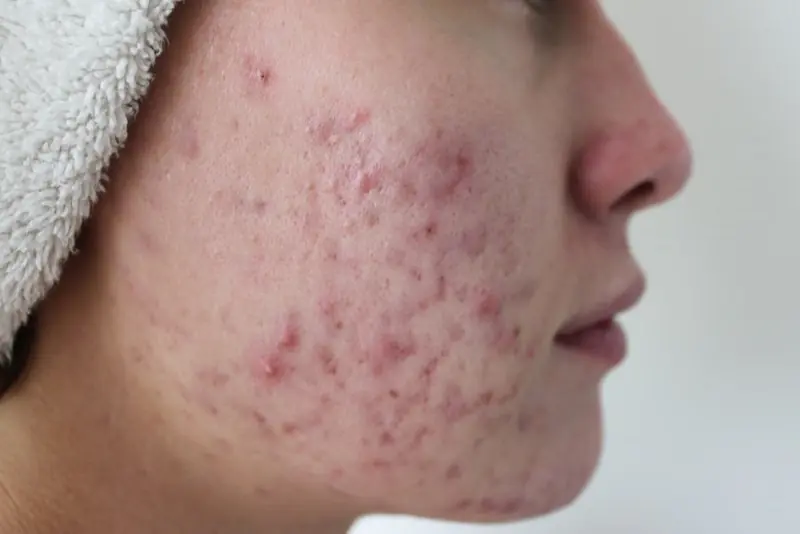
Pimples on the cheeks can represent various elements:
- comedones;
- papules (cavitated tubercle);
- pustules (abscess);
- cysts;
- nodes.
These can be single elements or multiple rashes merging with each other. Most often, acne appears on the cheeks and chin in the form of comedones and papulopustular rash. Less common is the severe form of cystic nodular acne.
Hormones as one of the causes of acne on the cheeks
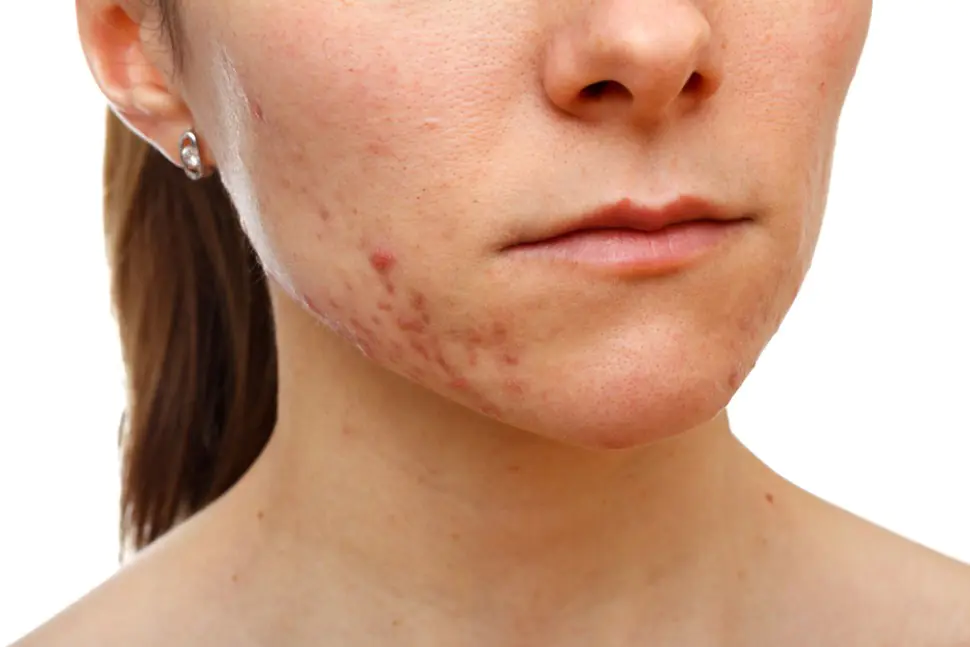
The skin is a target organ for many hormones. Therefore, when acne appears on the cheeks of women, their cause is primarily associated with a pathological hormonal state caused by a number of diseases.
Acne appears when 4 factors are triggered:
- sebaceous glands secrete excessive amounts of sebum;
- the cells lining the ducts of the hair follicle begin to actively grow and die;
- bacteria penetrate;
- inflammation begins.
Estrogens are hormones that suppress sebum secretion. Androgens, especially testosterone and dehydrotestosterone, have a strong effect and stimulate the function of the sebaceous glands.
The female reproductive and endocrine glands are the main sources of androgens (male hormones) in a girl’s body. A small proportion is also formed in adipose tissue and liver. Hormones increase the activity of the sebaceous glands, accelerate the exfoliation of epithelial cells and thereby contribute to the formation of non-inflammatory elements. When bacteria enters this area, an inflammatory process begins.
There are many reasons why androgen levels increase:
- in girls at the end of puberty (considered a physiological norm);
- polycystic ovary syndrome;
- congenital disorder of the adrenal cortex;
- tumor changes in the ovaries and adrenal glands;
- diabetes;
- pathologies of the thyroid gland;
- increase in body weight due to adipose tissue.
When pimples appear on the cheeks of girls, the reasons are associated with an increase in the amount of male hormones, then they are accompanied by other symptoms:
- menstrual irregularities;
- hair loss on the head;
- weight gain;
- Excessive male pattern facial hair growth.
In addition to diseases that cause an increase in androgen levels, when acne appears on the cheeks, the causes may be associated with even minor changes in the endocrine balance. Thus, acne on the cheeks may appear before menstruation, be a consequence of taking contraceptives or stopping their use and the use of anabolic steroids.
In half of the cases, the causes are associated with a hereditary predisposition to acne. It is noted that if the older generation in the family had this dermatological disease, in 70-80% of cases it will be inherited.
Cosmetical tools
The use of comedogenic cosmetics is another reason why acne on the cheeks can get worse and not go away for a long time. Long-term use of fatty creams, which contain, for example, isopropyl myristate, is a common cause of cosmetic acne in the form of comedones. When purchasing skincare products, you should opt for products labeled “non-comedogenic” or “non-acnegenic”
Moderate sun exposure has a disinfecting effect on the skin and dries out purulent rashes. However, excessive abuse of ultraviolet radiation (on the beach, in the solarium) has the opposite effect. The top layer of skin dries out, which acts as a signal to the sebaceous glands, and they begin to intensively produce secretions. Therefore, prolonged sun exposure provokes an exacerbation of existing acne and the appearance of new ones.
Stressful situations
It has been noted that women exposed to stress are more likely to suffer from acne. Stress is a trigger. Through nerve endings, it influences the production of neuropeptides, which in turn stimulate the sebaceous glands to produce more sebum. People suffering from acne have a greater number of nerve endings and more nerve fibers.
Nutrition and habits
Foods high in carbohydrates can increase the concentration of insulin in the blood. Insulin, in turn, increases androgen levels. The result of this connection is an increase in sebum production and acne.
If you already have rashes, excessive consumption of seafood, as well as foods high in iodine and bromine, can aggravate the situation.
Diet for acne is considered one of the links in complex therapy. You should include foods rich in fiber, Omega-3 acid, and vitamins A, C, and E into your diet.
One of the factors contributing to the appearance of acne is the habit of smoking. Nicotine reduces vitamin E concentrations and increases sebum production.
Acne as a sign of internal diseases
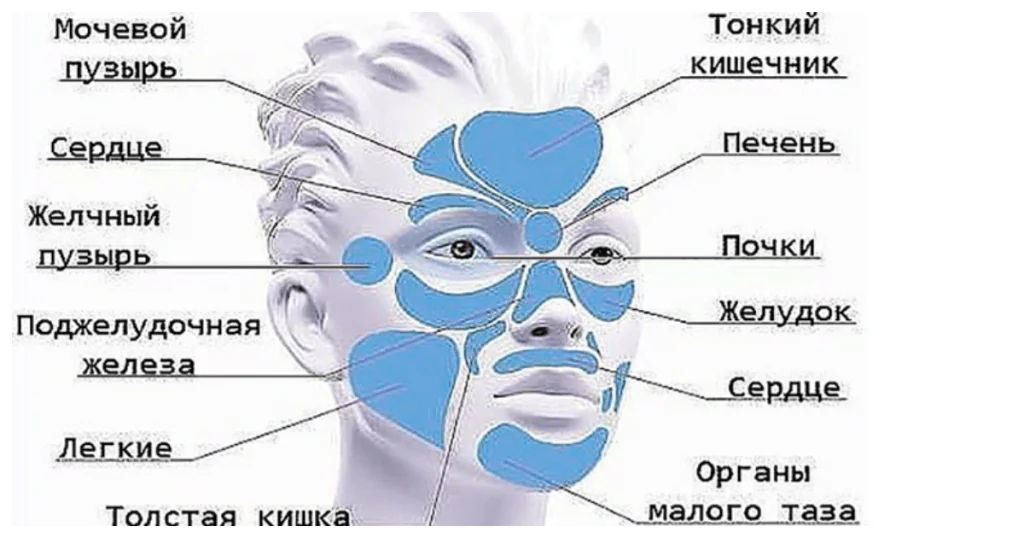
Eastern medicine still uses a technique according to which if there are problems with some internal organ, this is reflected in the condition of the skin in a certain area. So if acne appears on the right cheek, then the person has problems with the right lung, if acne appears on the left cheek, then it means the person has problems with the left. If the area of rashes is limited to the upper part of the cheeks, on the cheekbones, you should check the stomach. Of course, this technique is not a basis for making a diagnosis, but it can serve as a reason for conducting an examination of internal organs.
Principles of treatment
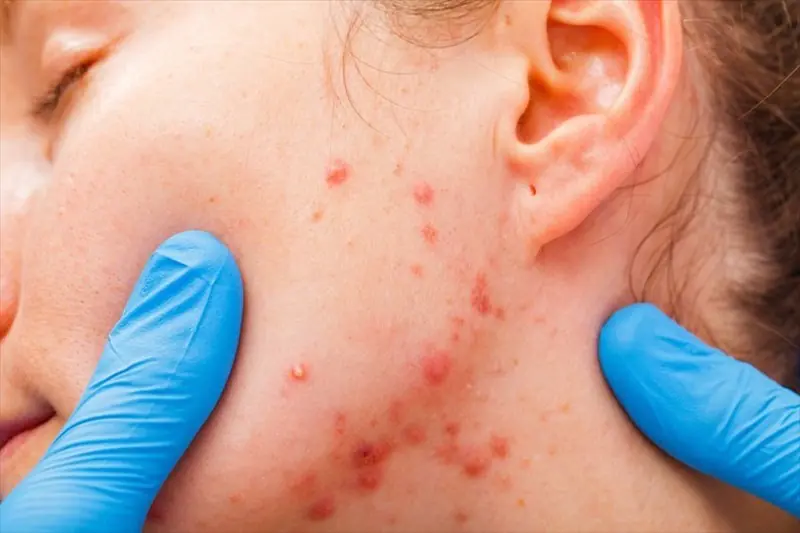
Before getting rid of acne on the cheeks, you should find out the causes of its appearance. To do this, you may need to undergo a hormonal profile study, take an insulin test, a dexamethasone test (for adrenal hormones), and a glucose tolerance test (for diabetes). Take a blood test to examine your liver and kidneys. In some cases, scraping is necessary to rule out demodicosis and folliculitis. Undergo a gynecological examination.
Hormone therapy
Acne associated with hormonal disorders should be treated under the supervision of a gynecologist and dermatovenerologist. Treatment begins with restoring hormonal levels and eliminating the causes that provoked its failure. At the same time, the dermatologist evaluates skin problems and prescribes local remedies.
If the area affected by acne is extensive, Spironolactone can be taken. It is a diuretic that can suppress androgens and thus help reduce the secretion of the sebaceous glands. The same drug is prescribed as a therapeutic agent for premenstrual syndrome.
The drug of choice is combined oral contraceptives, the effect of which is achieved in 70-100% of cases. These are such products as Diane 35, Yarina, Novinet, Janine, Regulon. Contraceptives are prescribed mainly between the ages of 20 and 40 to women for whom treatment with local drugs has not produced results. This treatment is also indicated for pustular elements concentrated in the lower part of the face, on the cheeks and on the neck.
At the same time, a noticeable improvement in skin condition is observed in women only after 3-4 months of taking contraceptives. In severe cases, therapy can reach 9 months or even a year. There are also side effects from this treatment. They can manifest as nausea and engorgement of the mammary glands. Such side effects in most cases disappear on their own within 1-2 months after the start of treatment. The most serious negative effect is a change in the condition of the blood, it becomes more viscous. For this reason, oral contraceptives are not prescribed to women with varicose veins, hypertension, and heavy smokers after the age of 35.
When acne appears during menopause, it is accompanied by symptoms of menopause such as insomnia, mood swings, sweating, and manifestations of vegetative-vascular dystonia. In this case, therapy is prescribed, the purpose of which is to stimulate the hormonal function of the ovaries. Drugs such as Climodien, Klimen, Angelique compensate for the lack of estrogen in the body and have a positive effect on the condition of the skin.
The place of antibiotics in acne treatment
Treatment of acne in women is rarely carried out with antibacterial drugs. Only with multiple inflammatory elements is it possible to prescribe them. One of the antibiotics used in therapy is Unidox Solutab. Other antibiotics (tetracycline, erythromycin, clindomycin, minocycline) are prescribed in long courses of up to 6 months. However, such prolonged treatment often leads to dysbiosis of the skin and intestines. Therefore, antibiotics are used in extreme cases when other drugs do not have a therapeutic effect.
Local remedies
Preference in acne treatment is given to local remedies:
- If most of the rashes are comedones, it is recommended to use Skinoren gel, Differin (cream, gel).
- For pustular elements, Baziron AS and Dalatsin are more effective.
- Ichthyol ointment is used to quickly resolve ulcers.
The girls' need for cosmetic care and their reluctance to get redness and irritation during treatment are taken into account. A special need for soothing cosmetic products can be seen during treatment with Baziron and Differin. Since drugs often cause dermatitis, medicinal cosmetics are a mandatory addition to therapy:
- Apezak emulsion helps with irritation.
- Gifak plus gel is recommended for cleansing.
- To resolve large formations, patches are produced - special plasters.
- For a large number of comedones, it is recommended to use aloe juice and citric acid-based gels. They soften plugs and help cleanse pores.
Local retinoids (Tretinoin, Retinol) are prescribed. Retinoids remain one of the most effective groups of medications against comedones. The active substances of retinoids relieve inflammation, reduce the level of secretion of the sebaceous glands, prevent clogging of follicles, and have an antioxidant effect. For women, taking retinoids is also an opportunity to reduce the depth of age wrinkles and their number.
Home care: recommendations and rules
The skin of women suffering from acne is dehydrated and more sensitive. This is due to the use of alcohol-containing products during the treatment of acne in youth and to the natural processes of age-related skin aging. Therefore, daily care for problem skin is an integral part of comprehensive treatment. It is not only aimed at treating acne, but also at eliminating dehydration, skin aging, pigmentation, and rosacea.
At home, it is important to follow simple rules:
- Wash with gentle cleansers with a neutral or slightly acidic pH. Products with sulfur and salicylic acid (2%) are effective.
- Try not to use scrubs and astringents during acne treatment. These products can irritate the skin and worsen the course of the disease.
- Use lotions with salicylic and glycolic acids. They remove excess fat from the skin and prevent the development of hyperkeratosis.
- Use a light moisturizer to prevent dry skin.
- Use water-based sunscreens and sprays.
Very often, when acne occurs on the cheeks of women, the cause lies in a malfunction of the endocrine system. Therefore, acne treatment should be carried out by several doctors: a dermatologist, gynecologist, endocrinologist and cosmetologist. Acne is a chronic disease and only an integrated approach to treatment will significantly increase the period of remission. The use of cosmetics makes it possible to reduce treatment time and drug doses, and also provides the necessary care for skin that has undergone age-related changes.
© Getty Images We found out why some people get them on their chins and others on their noses.
Few people think that every malfunction in the body is reflected on a certain part of the face in the form of single pimples appearing one after another or multiple rashes. In this article we will tell you why annoying defects do not want to leave your face, despite a long-standing struggle.
“Pimples and acne are inflammatory elements that usually appear due to improper care, poor nutrition, hormonal imbalance or increased sebum secretion. Let’s start with the fact that acne occurs at different ages and in different parts of the face: some mainly on the forehead, some on the nose, some on the chin, and everyone is worried about some area,” says Nadezhda Zabolotnaya, dermatovenerologist, specialist at the BEST Beauty and Health Center.
A rash on the upper part of the forehead indicates problems with the large intestine, and a rash on the lower part indicates problems with the small intestine. If acne appears in the area where hair begins to grow, malfunctions in the gallbladder and bladder are to blame.
Pimples on temples
The temples on both sides are a projection of the gallbladder. If there is an imbalance in its functioning, acne appears on the temples. Another culprit is the digestive system, namely poor nutrition. A clogged intestine simply releases toxins, and the blood carries them throughout the body. Further, liver function deteriorates, stomach acidity increases and dysbacteriosis occurs.
If pimples on your ears are your frequent guests, remember the last time you cleaned your phone. A huge number of bacteria live on it. Another reason is disruptions in the endocrine system and the initial stage of pathology of the gastrointestinal tract.
bridge of the nose
Pimples just above the bridge of the nose indicate a diseased liver. By looking at the rashes on the bridge of the nose itself, you can determine the presence of problems with the stomach and pancreas.
Severe black spots in the nose area are also a sign of blocked sebaceous glands. And for some, clogged sebaceous glands become inflamed, and when infections combine, inflammatory elements are formed
Eye area
If you sleep little and are very tired, not only bruises, but also pimples begin to reign under the eyes. Constant worries and stress are unkind to the area under the eyes. Acne also indicates an imbalance in the functioning of the kidneys and adrenal glands.
Are you worried about acne on your cheeks, chest and between your shoulder blades? Take care of your lungs. The right cheek is connected to the right lung, and the left, respectively, to the left. Pimples on the wings of the nose hint at problems with the bronchi. Therefore, with bronchitis, pimples and redness often appear on them, and the pores expand.
A rash on the wings of the nose extending to the bridge of the nose is a clear indication of a malfunction in the cardiovascular system. Perhaps you have arrhythmia or poor blood circulation is to blame for your acne, but there may be even worse ailments.
Chin
Rashes on the lower jaw are a sure sign of hormonal imbalances; however, poorly functioning ovaries and appendages may be to blame. Also, the problem may well be hidden in improper digestion or diseases in the oral cavity.
Pimples around the mouth often appear due to diseases of the digestive system, for example, you may be worried about bloating, indigestion, intestinal colic and constipation. Most often, the entire digestive system is affected, from the esophagus to the large intestine.
In case of rashes on the neck, it is worth thinking about the state of the endocrine and digestive systems, namely the intestines and stomach. The most dangerous sign is acne on the neck, chin and forehead at the same time: this indicates ovarian dysfunction.

What do acne on the face tell us? Very often, pimples accumulate in a certain part of the face, for example, on the forehead, cheeks, temples or chin. Other parts of the face always remain clean. In Eastern medicine it is believed that Any pimples on the skin are a consequence of problems with internal organs and various diseases. Many domestic cosmetologists also agree with Eastern medicine on this. Read on to the article if you want to know what do pimples on the face say, how to read a map of acne on the face, what organs you should pay attention to.
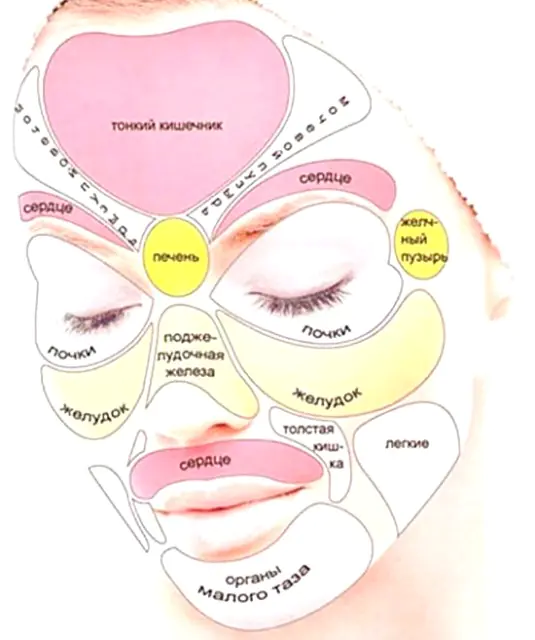
So, which organ is unhealthy can be determined by which part of the face you have acne.
What do pimples on your face say: pimples on your forehead
On the forehead there are several zones responsible for the functioning of organs:
- Pimples along the hairline indicate problems with the gallbladder.
- Pimples in the center of the forehead indicate poor bowel function. Excessive rashes on the forehead can also be caused by poor diet, consumption of large amounts of fatty and sweet foods, as well as medications and hormones. The upper part of the forehead is responsible for the large intestine, the lower part for the small intestine
- Pimples above the eyebrows indicate problems with the heart and intestines
- There are also areas on the forehead that are responsible for the functioning of the bladder.
Pimples on the forehead may indicate excessive slagging in the body, poor diet, and constant stress.
If you have problem skin on your forehead, you should reconsider your diet towards a healthier one, eat less sweet, starchy, fried, fatty, smoked, highly salty foods, and drink more water.
What do pimples on the face say: pimples on the temples
Pimples on the temples signal problems with the spleen and gall bladder
What do pimples on the face say: pimples on the bridge of the nose, between the eyebrows
Pimples in the area between the eyebrows (on the bridge of the nose) may indicate liver problems. She may be overloaded with alcohol, unhealthy fatty foods, and medications. As a result, it is difficult to cleanse the blood and cause acne on the bridge of the nose. It could also be problems with the pancreas. By the way, such hidden emotions as anger, for example, can also come out in the form of acne.
What do pimples on your face say: pimples on your nose
Pimples on the nose are caused by:
- problems with the pancreas and stomach (pimples on the upper part of the nose)
- problems with the cardiovascular system (most often acne on the tip of the nose). The skin suffers from poor blood circulation, which can cause rosacea and redness of the nose. A red tip of the nose may indicate arrhythmia, and a red nose may indicate high blood pressure. Lead a healthy lifestyle, engage in more physical activity, eat foods with B vitamins
- bronchial diseases (pimples and redness on the wings of the nose and nostrils)
What do pimples on the face say: pimples around the eyes, under the eyes (above the cheekbone)
Most often, pimples around the eyes indicate problems with the kidneys and adrenal glands. Review your diet, worry less, rest more and take care of healthy sleep.
What do pimples on the face say: pimples on the cheeks
Pimples on the upper cheeks (under the cheekbone line) indicate stomach problems. Try to eat properly separately, do not drink water during and after meals, limit the consumption of fatty and other junk foods, as well as milk
Pimples on the middle and lower cheeks, as well as on the chest and back between the shoulder blades can be caused by problems with the lungs. The right cheek is responsible for the right lung, and the left cheek is responsible for the left. Lung diseases can be expressed in red spots, problems with capillaries.
Chinese scientists believe that they occur when there is a lack of joy, physical activity, fresh air, and also due to smoking. Heavy and unbalanced energy accumulates and pimples form.
It is also common to encounter acne in these places during adolescence, as well as due to allergic reactions.
Pimples on the cheeks in the lower part (along the face line) can be caused by diseases of the mouth, teeth and gums.
What do pimples on your face say: pimples on your chin
Acne on the chin, as well as unwanted hair in women, can be caused by hormonal imbalance, increased levels of male hormones (androgens). Another reason is problems and congestion in the pelvic area. In women, this may be associated with gynecological and endocrine diseases, in men – with the development of prostatitis. You should go to a gynecologist to check the ovaries and appendages; for men, see a urologist. Have an endocrinologist check your hormones.
Also, acne on the chin can be caused by stress, lack of sleep, alcohol and coffee abuse.
What do pimples on your face say: pimples around the lips
Pimples on the sides of the lips, as well as on the shoulders, can be caused by problems with the digestive system, most often the large intestine. May be accompanied by constipation, intestinal colic, and indigestion. Chinese scientists believe that such acne is more common in vulnerable and sensitive people, those who take everything to heart. It is worth limiting alcohol, tea, coffee, and junk food. Eat healthy foods regularly and worry less.
Pimples above the lips can give you a signal about problems with the cardiovascular system.
Pimples on the corners of the lips and upper lip can be caused by problems with the duodenum, on the central part of the lower lip - by the small intestine, on the edges of the lower lip - by the large intestine.
What do pimples on the neck say?
Pimples on the neck may indicate problems in the endocrine or digestive system. They can also be caused by colds or infectious diseases. Red spots and rashes on the neck can also be a result of allergies.
What do pimples on the face say: conclusions
We hope this acne map article helps you understand your body better. This does not mean that if one pimple pops up on your cheek, you should immediately run to check your lungs. Perhaps you just don't cleanse your skin well or grab your face with dirty hands. But if you constantly have pimples in the same places, and accumulate in certain parts of the face, then you should go to the doctor and check the condition of the corresponding organs of the body.
Write in the commentsWhat do you think about the relationship between the location of acne and diseases? Have you ever noticed such correspondences? After this article, have you decided to go to the doctor to check the functioning of some of your organs, for example, the intestines? Will you keep an eye on what do pimples on your face say??
You may also be interested in the following articles:
76 thoughts on “What do pimples on the face say: a map of acne and diseases”
First, you need to change your diet. Not a diet, but a lifestyle itself. Get a thorough diagnosis. Medicines can only delay the problem - they will relieve the inflammatory process on the skin, but the causes that cause acne will remain... This is a dangerous path
There seems to be a grain of common sense here, but it seems to me that all this is very strange. Why then do external remedies help? After a course of Metrogil, for example, my face can be clear for a month. Organs are not treated in this case.
So the fact of the matter is that when the reason is there, then the same Metrogil removes acne only for a while. That’s why we need to remove the reason...
I'm struggling with my face. I constantly have acne in all places. Detected inflammation of the 12th cirrus. How to treat . I have everything that is listed. 😞
Of course, if you have acne, you need to undergo a full examination. But they don’t do this here, and doctors don’t prescribe anything—they prescribe a standard regimen, and that’s it. I went to a dermatologist here and was told to use Skinoren and Metrogyl, the traditional method. And not a word about doing tests or anything else.
Guys! Because of my nervousness, and not only because of this, my face broke out (I was unemployed and without a salary for 3 months), I also had a loan, I was depressed, I was worried a lot, so everything turned out, fortunately everything got better, but the acne never went away , no, it's more like acne. So, I went to a dermatologist, she told me that this was most likely a disorder of the gastrointestinal tract, possibly parasites in the blood (giardia), stagnation of bile, Helicobacter pylori, and you won’t believe it, but after the examination everything, EVERYTHING was confirmed, tomorrow I’m going to a gastroenterologist for medications and diet, plus it turned out I had a bad heart, only my liver and kidneys were fine+
It all started with a temperature of 41C and intoxication and diarrhea. Without any tests, the doctor later said that it was pneumonia and prescribed Flemoxin. It passed, but other problems appeared, including hair loss, pimples on the forehead, temples and closer to the hair and even ears, I have to wash my hair every day, although before that I washed it once every 10 days and not a single hair fell, but now it’s just a mess. I began to fall asleep at 7 pm and with great difficulty get up at 12 pm. It’s like I get enough sleep, and when I don’t get enough sleep, I sleep it off while studying.
The problem has been bothering me for 4 years.
Sorry for the details. I think you can tell approximately what happened to me on that fateful day.



